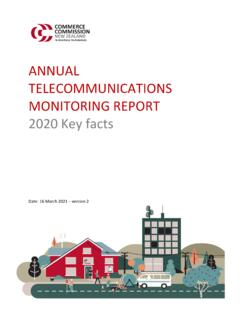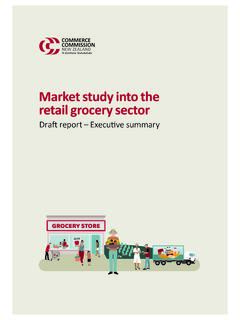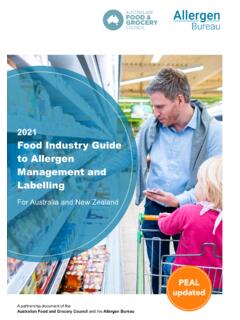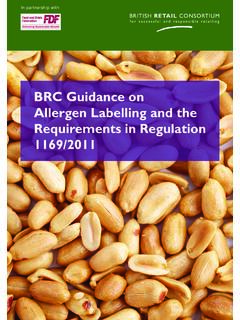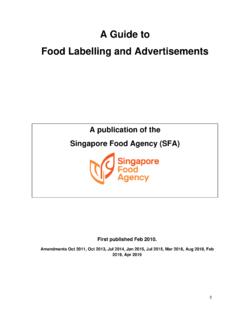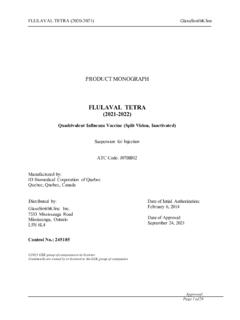Transcription of a guide for traders
1 GUIDELINE DECEMBER 2021 Origin of Food Regulationsa guide for tradersFOOD MARKETNZ APPLESSPECIALSSPECIALSSPECIALSFISH STALLPRODUCT OFNEW ZEALANDPRODUCT OFNEW ZEALANDFRESH FRUIT Origin of Food Regulations a guide for traders1 December 2021 ContentsIntroduction 2 Background 2 What types of food are covered by the Regulations? 3 What is considered a food item ? 3 What does fruit or vegetable mean? 4 What is fresh food? 4 What does minimally processed mean? 5 What does cured pork mean? 5 Who do the Regulations apply to? 6 What origin information must be provided? 7 How to disclose the origin information 8 Clear and legible text 8 Enable consumers to be informed 8 Connection to the regulated food item is clear 10 Modifications to the general disclosure requirement 11 Regulation 12: Additional information if origin changes by time of supply 11 Regulation 13: Replacement information if origin differs between stores 11 Regulation 14: Optional replacement information if origin changes often 12 Regulation 15.
2 Optional replacement information if origin changes often for meat or cured pork 12 Exceptions to the general disclosure requirement 13 Commerce commission enforcement 14 What might happen if you don t comply with the regulations? 14 False, misleading, or unsubstantiated representations about country of origin 14 Other information 15 Making a complaint 15 Further information sources 15 Self-check: do the Regulations apply to you? 16 FOOD MARKETNZ APPLESSPECIALSSPECIALSSPECIALSFISH STALLPRODUCT OFNEW ZEALANDPRODUCT OFNEW ZEALANDFRESH FRUIT Origin of Food Regulations a guide for traders2 December 2021 IntroductionThese guidelines aim to help traders understand their obligations to label certain foods with their country of origin under the Consumer Information Standards (Origin of Food) Regulations Consumer Information Standards (Origin of Food) Regulations 2021 (Regulations) were passed by Parliament on 10 May 2021.
3 The Regulations introduce mandatory origin disclosure for certain foods. These guidelines provide information about what you need to do if you supply or offer to supply foods covered by the can use the self-check questionnaire at the back of these guidelines to help assess whether the Regulations apply to you. This document provides general guidance about the Regulations. We may update it from time to document is not exhaustive and is not intended to be legally binding. As the enforcement agency, the Commission cannot provide legal advice to individual businesses or advice about specific scenarios. Ultimately, only the courts can decide if the Regulations have been breached.
4 For specific advice about the application of the law, we recommend you seek legal advice. A relevant industry association may also be a source of useful purpose of the Regulations is to ensure consumers have information about the origin of certain foods so that they can make informed purchasing Regulations apply to regulated food items that are fresh or thawed or frozen. The Regulations apply to fresh or thawed food items from 12 February 2022. The Regulations apply to frozen food items from 12 May Regulations describe the types of food that must have an origin disclosure, how disclosure can be made and the circumstances under which disclosure will be Commerce Commission enforces compliance with the Regulations under the Fair Trading Act.
5 Origin of Food Regulations a guide for traders3 December 2021 What types of food are covered by the Regulations?Food items covered by the Regulations are called regulated food items . Regulation 5(2) sets out the food types that are regulated food items: fruit, vegetables, meat, finfish or shellfish, that is only one type fresh, thawed (but would otherwise be fresh), or frozen, and no more than minimally processed cured food that does not fall into either of the above categories is not covered by the Regulations for example, eggs and dairy of the terms used to describe the foods that fall within Regulation 5(2) are further defined in the Regulations and we discuss those in more detail in the next few sections.
6 EXAMPLESR egulated food items that meet the one type criteria in Regulation 5(2)(a) Apples, cabbage, beef, snapper, and mussels all of these could be sold loose or in a package including only that one type of food item. Regulated food items that do NOT meet the one type criteria in Regulation 5(2)(a) Mixed bags of frozen peas and corn, a meat pack containing both beef steak and lamb chops, meatballs containing herbs, garlic and onion, a container of mixed green and red is considered a food item ?The word item is a defined term under Regulation 4 and means each separate unit or package of food supplied, offered or advertised for supply.
7 An item can mean: each loose unit of food that might be sold by weight or by each piece (for example, a watermelon), and a package of multiple pieces of food (for example, a package of peas).We do not consider it likely that meal boxes containing multiple ingredients, or mixed fruit and vegetable boxes (where the customer does not nominate the contents), for a fixed price are captured by the Regulations. Nevertheless, we encourage meal box and mixed fruit and vegetable box suppliers to disclose to customers the origin of the items included in the boxes, where it is practical to do so. Delivered fruit and vegetable boxes that only contain fruit and vegetable items selected by the customer may be captured by the Regulations and the country of origin of each type of fruit and vegetable should be disclosed.
8 Origin of Food Regulations a guide for traders4 December 2021 What does fruit or vegetable mean?The words fruit or vegetable are defined terms under Regulation 4 and mean a plant, or part of a plant, that can be eaten as food . What is fresh food?Regulation 6(1) sets out that a food is considered fresh if it has not been processed for the purpose of preserving it or extending the period during which it may be eaten. Food can still be considered fresh if it has been through some types of processing set out in Regulation 6(2) refrigeration or chilling, surface treatment, vacuum sealing, blanching before freezing. These examples are intended to expand on the meaning of Regulation 6(1), which could otherwise be interpreted quite narrowly.
9 Likewise, food that has been frozen and then thawed before selling is considered Fresh food Chilled whole raw fish, vacuum sealed bag of raw garlic 6(3) lists examples of processing where a food will no longer be considered as fresh. Some of these examples are drying, dehydration, pickling, smoking, canning, preserving (in salt, sugar, or oil), or cooking (other than blanching before freezing).EXAMPLESF oods that are not fresh Smoked fish, canned oysters, olives in brine, dried mushrooms, kimchi, dried following items are also specifically included as fruit or vegetable in Regulation 4: mushrooms or edible fungus sprouted legumes coconut green beans or peas snowpeas edamame beans broad beans following items are excluded (unless they are specifically included as fruit or vegetables in the list opposite): nuts seeds legumes grains herbs growing in soil.
10 Origin of Food Regulations a guide for traders5 December 2021 What does minimally processed mean?Regulation 7 sets out the meaning of minimally processed. Minimally processed includes, for example, cutting, chopping, slicing, dicing, mincing, grating, mashing, juicing, blending, pur eing, filleting, deboning, shucking, peeling, shelling, washing, sanitising or irradiation. Foods covered by the Regulations that have been through these processes will require country of origin disclosures. Cured pork will always require country of origin that is no more than minimally processed A package of fresh sliced mushrooms, skinless and deboned chicken thighs, minced beef with no consider single ingredient fruit juices may not be regulated food items because of the amount of processing required to make juice.

